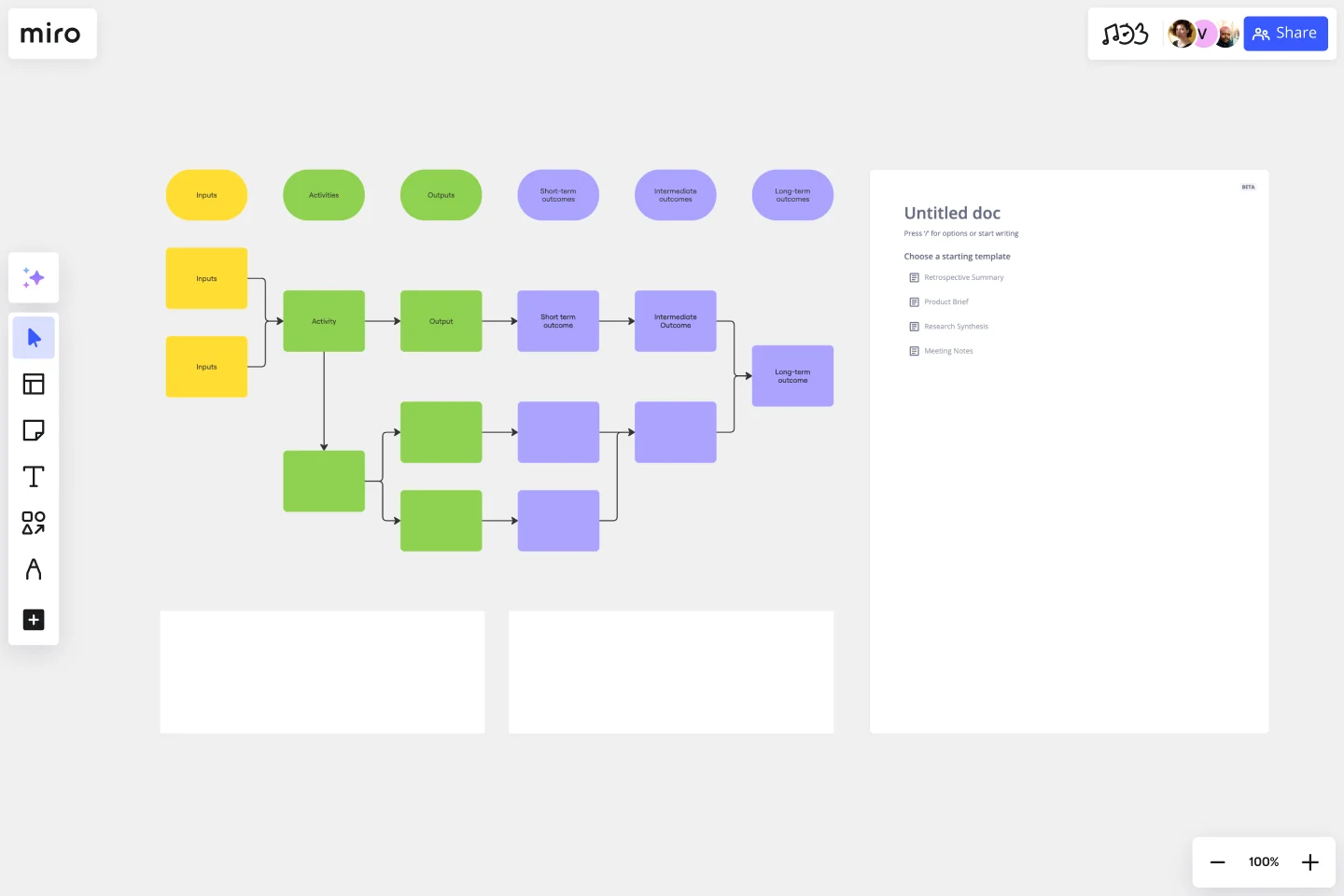Logic Model Template
Outline your program’s activities and outputs with the logic model template. Map out the project lifecycle and bring alignment to teams.
About the Logic Model Template
This logic model template offers an illustrative approach to program planning, evaluation, and management. The template visually represents the connection between resources, activities, and desired outcomes, ensuring a clear roadmap for your project or initiative.
Businesses, nonprofits, and educators can use the logic model template to visually depict the relationship between program inputs, activities, outputs, and outcomes. It illustrates how the invested resources will be transformed into the anticipated results through interconnected steps.
Step-by-step guide to using the logic model template
Setting up the logic model template to fit your project or business is easy. Start by opening the template onto a Miro board, then follow this guide to customize it to your needs.
Edit the template: Click on any element within the template to quickly edit or change it. You can change text, colors, or reposition sections as needed.
Expand with automated diagramming: If you need to add more sections or components, use Miro’s automated diagramming feature by clicking on shapes and connector lines. This lets you seamlessly expand and edit the existing structure of the template.
Add artifacts: To make your logic model more comprehensive, drag and drop any documents, images, links, or other artifacts onto the board.
Collaborate in real-time: Invite team members to join the board. They can provide instant input, comments, or feedback, ensuring a collaborative approach.
Share and collect feedback: Once your logic model is complete, you can share the board with stakeholders or team members for further review or implementation.
Why use a logic model template?
Clear visualization: The template provides a visual map, enabling stakeholders to quickly understand the entire project lifecycle and its components.
Improved resource allocation: Clearly defining inputs and anticipated outcomes ensures resources are used efficiently and directed toward activities that genuinely matter.
Alignment with goals: The template ensures all activities align with the overarching project or program goals, minimizing deviations or distractions.
Facilitates evaluation: With the logic model, it's easier to monitor and evaluate a program's effectiveness, pinpointing improvement areas.
Stakeholder communication: The template acts as a shared language, making communicating complex ideas or plans to different stakeholders simpler.
If you'd prefer to start from scratch, Miro's flowchart maker is the perfect tool to diagram a logic model. You can add shapes and connector lines with just one click.
Can I customize the logic model template?
The template is designed to be flexible, allowing you to tailor it according to your specific needs and preferences.
Can multiple team members collaborate on the template in real time?
The template supports real-time collaboration, ensuring all stakeholders can provide input and feedback instantly.
What kind of projects or initiatives is the logic model template best suited for?
The template is versatile and can be used for various projects, from educational initiatives and nonprofit programs to business projects and strategic planning.
Do I need any special skills to use the logic model template?
Not at all! The template is user-friendly, and even if you're new to such tools, you'll find it intuitive and easy to navigate.
Get started with this template right now.
Cloudflare Automatic Captioning for Video Template
The Cloudflare Automatic Captioning for Video Template in Miro is a powerful tool designed to enhance the accessibility and engagement of video content. By leveraging Cloudflare's technology, this template helps outline the captioning process for videos. It not only makes content accessible to a broader audience, including those who are deaf or hard of hearing but also boost viewer engagement by making videos consumable in sound-sensitive environments or by individuals who prefer reading along.
Causal Loop Diagrams (1.0)
Works best for:
Diagramming
The Causal Loop Diagrams (1.0) template offers a visual tool for modeling complex systems and understanding the feedback loops that drive behavior. It provides a structured framework for identifying causal relationships, reinforcing loops, and balancing feedback within a system. This template enables teams to analyze system dynamics, anticipate unintended consequences, and formulate effective strategies for intervention. By promoting systems thinking and understanding of interdependencies, Causal Loop Diagrams empower organizations to navigate complexity and drive sustainable change.
Pie Chart Template
Works best for:
Education, Operations
Pie charts are an excellent way to present relationships between datasets graphically, where you can quickly compare information and see contrast right away. Professionals from many fields use pie charts to support their presentations and enrich their storytelling as it’s one of the most commonly used data charts.
Production Flowchart Template
Works best for:
Flowcharts
The Production Flowchart Template is a well-crafted tool that clearly represents a production process from start to finish. It breaks down complex procedures into easy-to-understand segments, making it easier for stakeholders to grasp the entire process. One of the key benefits of using this template is that it helps to clarify complex production pathways. By mapping out operations visually, teams can identify potential bottlenecks or inefficiencies, facilitating timely and well-informed decision-making.
UML Sequence E-commerce Checkout Template
Works best for:
UML
The UML Sequence E-commerce Checkout Template in Miro is a versatile tool for visualizing and analyzing e-commerce checkout processes. It provides a step-by-step visual representation of system interactions, is highly customizable, supports real-time collaboration, and is suitable for various e-commerce platforms. It serves as an efficient documentation tool, fosters team collaboration, and contributes to a more streamlined checkout experience for customers.
UML Sequence Diagram Template
Works best for:
Software Development, Mapping, Diagrams
Analyze and showcase how external entities interact with your system using a sequence diagram. Get a bird’s-eye view of your work processes, business functions, and customer interactions using this diagram. Also, identify any potential problems early and solve them before implementation.
